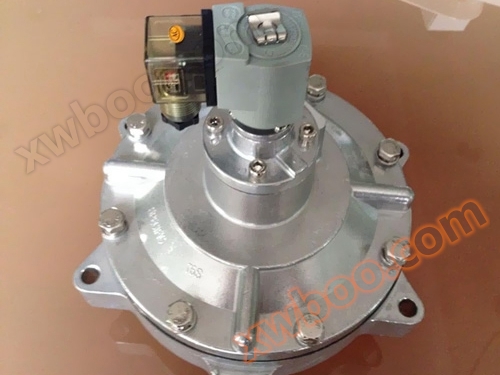
The submerged electromagnetic pulse valve seat is embedded in the air bag for installation, with low resistance, good circulation, high injection volume, increased load carrying capacity, and expanded range of gas source pressure. It is suitable for use in situations with a wide range of gas source pressures.
working principle:
The diaphragm divides the submerged electromagnetic pulse valve into two chambers, front and rear. When compressed air is connected, it enters the rear chamber through the throttle hole. At this time, the pressure in the rear chamber presses the diaphragm component tightly against the output port of the valve, and the electromagnetic pulse valve is in the "closed" state.
The electrical signal of the pulse jet control device causes the electromagnetic pulse valve armature to move backwards, the vent hole in the rear chamber of the valve opens, the rear chamber rapidly loses pressure, the diaphragm component moves backwards, compressed air is blown through the valve output port, and the electromagnetic pulse valve is in the "open" state. The electrical signal of the pulse jet controller disappears, the electromagnetic pulse valve armature resets, the rear chamber vent hole closes, and the pressure in the rear chamber increases, causing the diaphragm component to tightly adhere to the output port of the valve. The electromagnetic pulse valve is then in the "closed" state.
Technical requirements for submerged electromagnetic pulse valve:
1. The working pressure of the product is 0.1MPa to 0.7MPa, and the medium is air that has undergone oil and water removal treatment.
2. When the operating voltage of the solenoid valve is 85% of the rated voltage under the nominal gas source pressure of the product, the opening response time of the electromagnetic pulse valve should be less than 0.03s.
3. When the working gas source pressure is 0.1MPa, the pulse valve can be closed.
4. The product should be able to withstand a gas source pressure of 0.8 MPa.
5. Under specified environmental conditions, the insulation resistance of the electromagnetic coil to the casing should be greater than 1M Ω.
6. Under the conditions of room temperature ranging from 5 ° C to 35 ° C and relative humidity not exceeding 85%, the electromagnetic coil can withstand a voltage of 50Hz and 250V on the casing without breakdown for 1 minute.
7. The electromagnetic pulse valve should be able to operate normally after being subjected to vibration with a frequency of 20Hz, a full amplitude of 2mm, and a duration of 30 minutes.
8. Under normal usage conditions, the cumulative service life of the membrane should be greater than 800000 times.
9. The surface of the valve has no obvious coating peeling, scratches, burrs or other damages.

